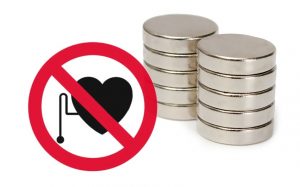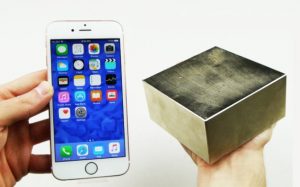Neodymium magnets and safety
This article provides an overview of the safety hazards associated with neodymium magnets and how to avoid them.
Swallowing
If two or more magnets are swallowed, they may become trapped in the intestines, which can lead to serious health complications. Magnets are not toys. Keep magnets out of the reach of children.
Magnets are brittle
Neodymium magnets attract with great force. They may break or splinter upon impact, so handle them with care. When strong magnets collide, sharp fragments may fly several metres and injure the eyes. When working with larger magnets, wear safety goggles and make sure other people are either protected or kept at a safe distance. A video guide on separating and joining magnets can be found at www.orodian.com/handling
Contusions
Neodymium magnets have a very strong attractive force. Handling them requires extreme caution. If mishandled, they may pinch the skin or fingers and cause bruises or serious injuries. Very large magnets may even crush bones. Sturdy protective gloves must be worn when handling large magnets. Before handling large magnets, watch the video guide at www.orodian.com/handling
Pacemaker
Magnets can interfere with the function of pacemakers and implanted defibrillators. A pacemaker may switch to test mode in the presence of magnets, which can cause nausea. A defibrillator may fail to operate. If you are a wearer of these devices, keep a safe distance from magnets. Warn other wearers of these devices not to approach magnets. More information at www.orodian.com/pacemaker
Heavy objects
Excessive or impact overloading, or damage to the magnet, may cause the magnet or magnetic hook to detach from the attracted surface. The specified magnetic strength (pull-off force) applies only under ideal conditions. Therefore, factor in a large safety margin.
Falling objects can cause serious injuries. Do not use magnets in places where magnet failure could result in injury to people.
Magnetic field
Magnets produce a strong magnetic field that can damage TVs, laptops, certain types of watches, headphones, speakers, and other electronic devices, as well as erase data on hard drives, cassette tapes, and payment cards. Therefore, keep magnets at a safe distance from these types of items. A reference table of safe distances can be found at www.orodian.com/magnets-and-electronics
Do not place neodymium magnets near weaker types of magnets (magnetic sheets and tapes, ferrites, AlNiCo, SmCo). Their strong magnetic field could demagnetize weaker magnets.
Allergy to nickel
Most of our magnets contain nickel. Some people may have an allergic reaction to nickel. In some people, long-term contact with nickel-plated magnets can lead to a nickel allergy. Avoid prolonged contact between nickel-plated magnets and your skin. If you already have a nickel allergy, avoid any contact with magnets.
Shipping by mail
The magnetic field around a package may damage nearby parcels or postal sorting equipment. For shipping, place the magnets in a box lined with material on all inner sides to ensure a safe distance between the magnets and the outer surface. Inside the package, arrange the magnets in such a way that their magnetic fields cancel each other out. In the case of very strong magnets, you may use steel sheets to block or redirect the magnetic field, preventing it from affecting surrounding items or equipment.
Transport by plane
The magnetic field of improperly packaged magnets can interfere with aircraft navigation systems. When transporting magnets by plane or shipping them abroad, make sure the packaging complies with all relevant safety standards.
Oxidation
Neodymium magnets without a protective coating will oxidize and weaken over time. That is why all our magnets are protected with a surface treatment. Avoid any damage to the coating.
The most common nickel-copper-nickel coating is not resistant to moisture and is not suitable for outdoor use. For outdoor use, rubber, plastic, or epoxy resin coatings are more appropriate.
Learn more about the advantages and disadvantages of different coatings at www.orodian.com/surface-treatment
Temperature resistance
Conventional neodymium magnets lose part of their strength at temperatures above 80°C. Do not expose magnets to extremely high temperatures. If you need magnets with higher thermal resistance, use the form at www.orodian.com/custom-magnets
Mechanical processing
Neodymium magnets are brittle, sensitive to high temperatures, and easily oxidize.
Drilling or sawing with unsuitable tools can cause the magnet to break. A magnet with a damaged coating will start to oxidize and lose strength over time.
A magnet may also lose strength due to the generated heat. Moreover, the hot metallic dust produced can ignite. Avoid mechanical processing of magnets.
If you require a specific shape or have other special requirements, we can provide custom-made magnets. More information at www.orodian.com/custom-magnets


